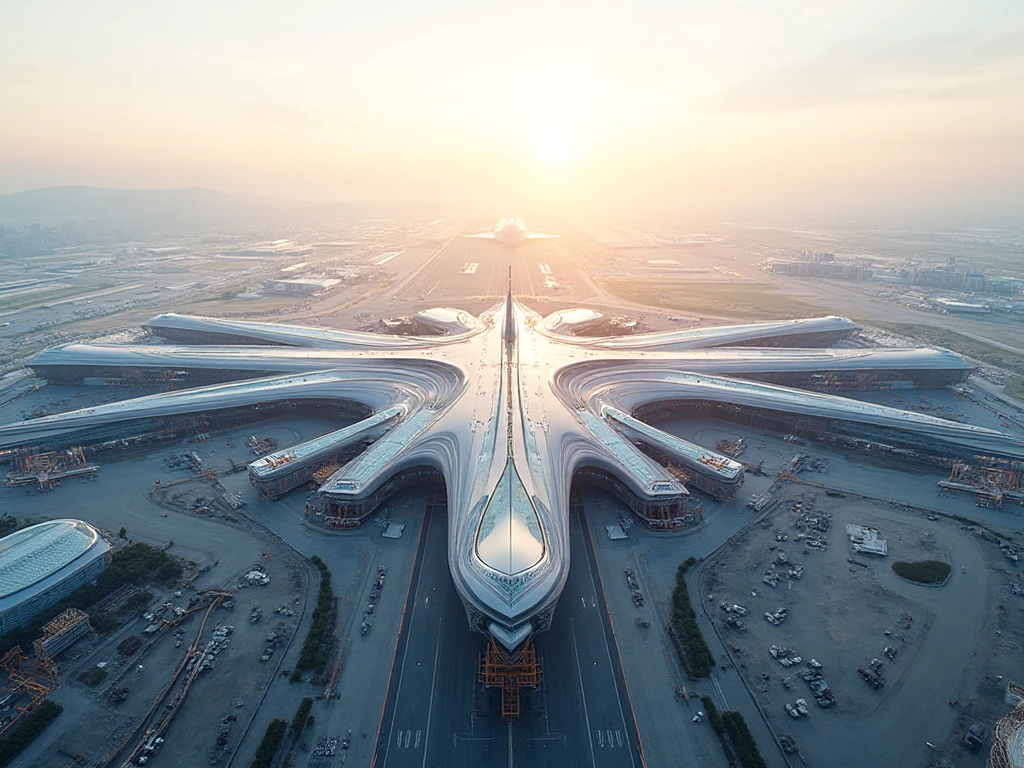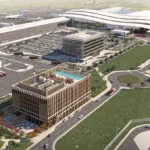Top 10 Massive Airport Megaprojects Transforming Global Aviation
Air travel is being rebuilt at scale: these 10 airport megaprojects are remapping global routes, logistics, and city economies. Read fast, think big, and pick your next airport to watch.
Why Airport Megaprojects Matter Now
Airport megaprojects are more than big construction jobs. They are national bets on trade, tourism, and technology. Massive new terminals, multi-runway hubs, and complete airport cities change regional connectivity. In return, this has created thousands of jobs and redefined supply chains for decades.
This article ranks ten of the most consequential airport megaprojects currently underway, explains what each delivers, and highlights the costs, technology, and risks behind the headlines.
Top 10 Massive Airport Megaprojects: How the Ranking Was Chosen
Projects were selected for scale, strategic impact, current activity (2024–2025), and public documentation of costs, capacity, or construction milestones. Each entry includes a snapshot of the development, measurable impact to date, core technologies, and challenges ahead.
1. Al Maktoum International Airport, Dubai (Dubai World Central)
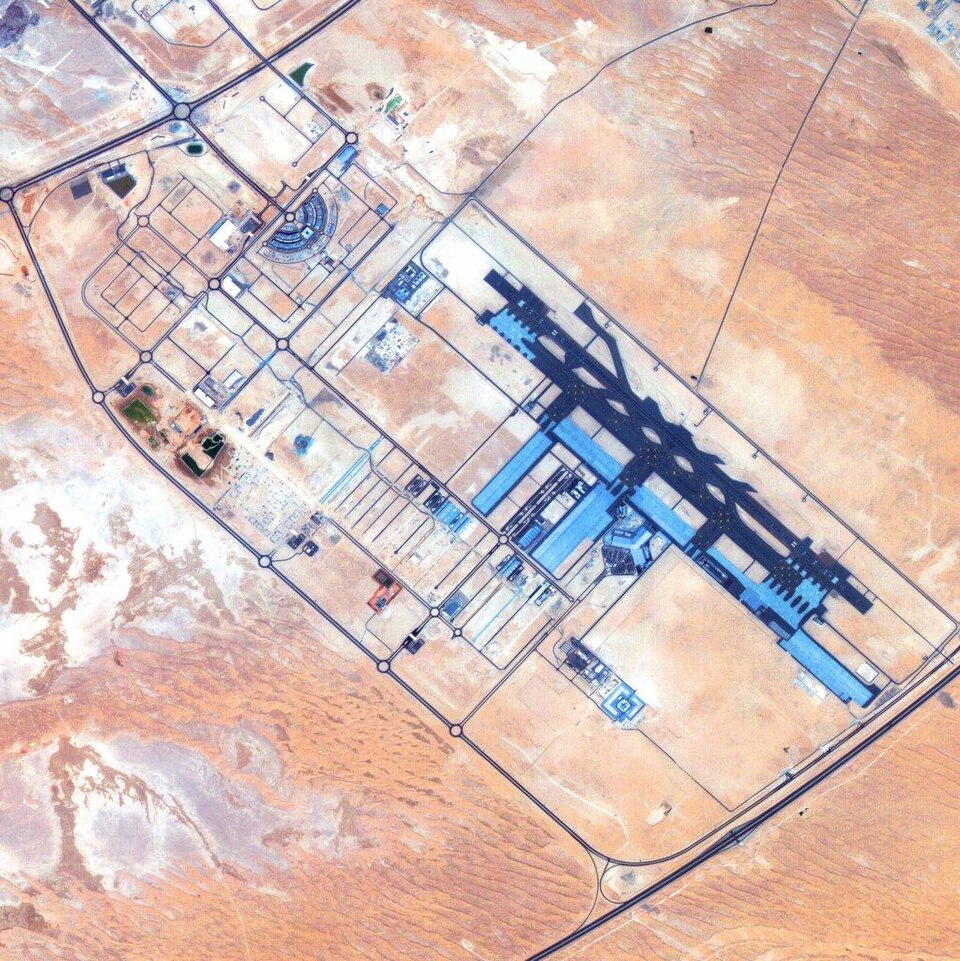
Project snapshot:
Dubai’s long-term plan to scale Al Maktoum International airport, also known as Dubai World Central (DWC-AMIA), into a city-scale aviation hub is one of the boldest airport megaprojects on the planet. Authorities envisage multiple runways and a passenger capacity that could top 150 million per year in the coming phases.
What it delivers:
- Massive capacity to absorb Emirates and wider Gulf hub traffic.
- Integrated logistics and cargo precinct aimed at capturing global freight flows.
- A new urban footprint spanning tens of square kilometres.
Tech and design:
Digital master planning, large-scale earthworks, and staged runway construction will be critical, as bespoke cargo handling automation becomes essential when full capacity is achieved.
Impact so far:
Construction of the airport, worth an estimated cost of $35 billion, is phased to match Dubai’s growth; the project is a regional magnet for investment in logistics and hospitality. Local job creation and major supply-chain contracts follow the build programmes.
Challenges and risks:
This megaproject faces high capital intensity, phasing risks if global travel patterns shift, and the ongoing need for alignment of ground transport corridors to efficiently move passengers to the site.
What to watch next:
How the Dubai sequences transfer from DXB to DWC, and how cargo automation plans scale as new gates and runways are opened.
2. King Salman International Airport, Riyadh (Saudi Arabia)
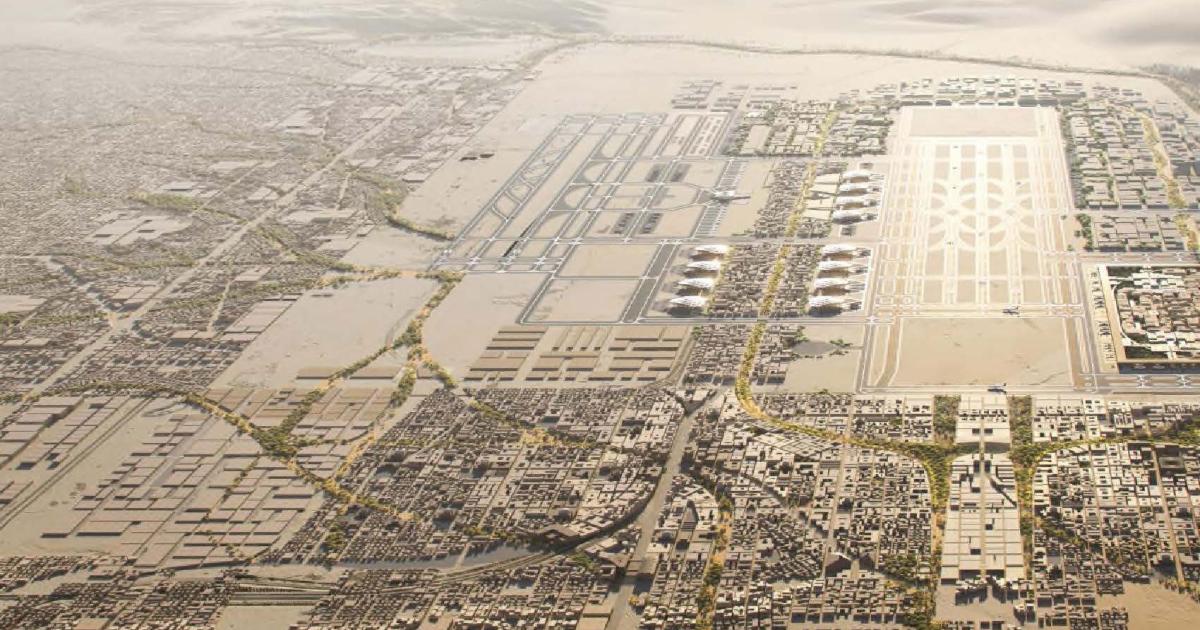
Project snapshot:
Billed as Saudi Arabia’s mega gateway under Vision 2030, King Salman International will be an enormous network of runways and terminals designed to handle more than 100 million passengers annually by 2030. Foster + Partners is among the design firms associated with the scheme.
What it delivers:
- A national hub for tourism, pilgrimage, and transit.
- Multiple parallel runways and a cluster of terminals to scale capacity over time.
- New retail, logistics, and services zones to capture non-aeronautical revenue.
Tech and design:
Emphasis on climate-adapted architecture, high-capacity baggage and people movers, and expansive duty-free and retail space.
Impact so far:
The project signals Riyadh’s intent to compete with long-haul hubs; it drives large procurement and local content plans that support jobs and industrial suppliers.
Challenges and risks:
Massive land use change, connectivity to the city, water and energy constraints in arid regions, and global aviation demand dependency.
What to watch next:
Phasing plans that link existing King Khalid International Airport facilities to the new terminal network, and progress on runway construction and environmental approvals.
3. Istanbul Airport, Turkey
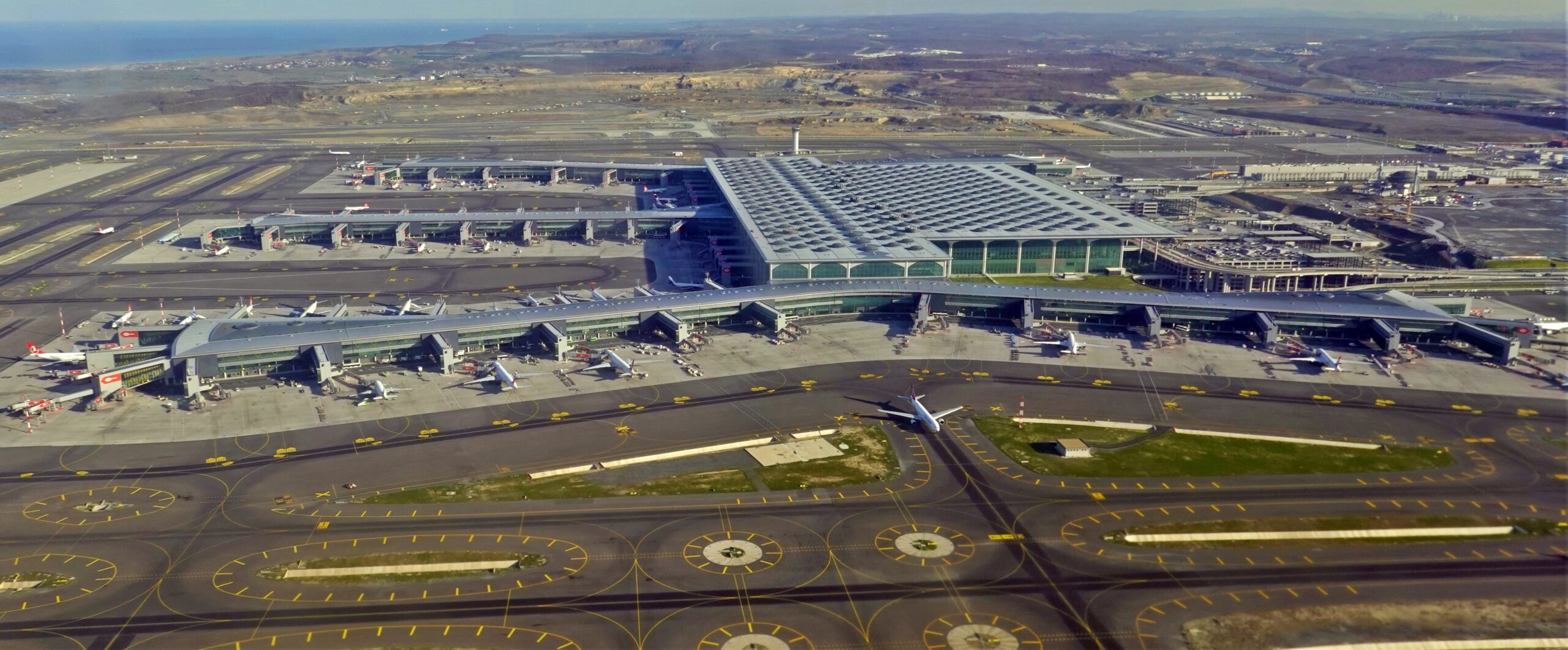
Project snapshot:
Opened in phases, Istanbul Airport is already one of the world’s most ambitious aviation projects. Its masterplan capacity could reach around 200 million passengers after all phases. The terminal complex and runway system reposition Istanbul as a central intercontinental hub.
What it delivers:
- A centralised hub connecting Europe, Asia, and Africa with high transfer efficiency.
- Large apron and gate capacity plus modern transfer corridors.
- Cargo and logistics expansions to capture the trans-Eurasia trade.
Tech and design:
Large single-terminal flows, automated baggage systems, and phased runway additions for capacity scaling.
Impact so far:
Rapid passenger growth has boosted tourism and transit; Istanbul commands stronger carrier networks and trade volumes.
Challenges and risks:
Noise, environmental mitigation, and aligning airport access with wider metro and rail networks.
What to watch next:
Completion of remaining capacity phases and improvement in regional surface connections.
4. Beijing Daxing International Airport, China
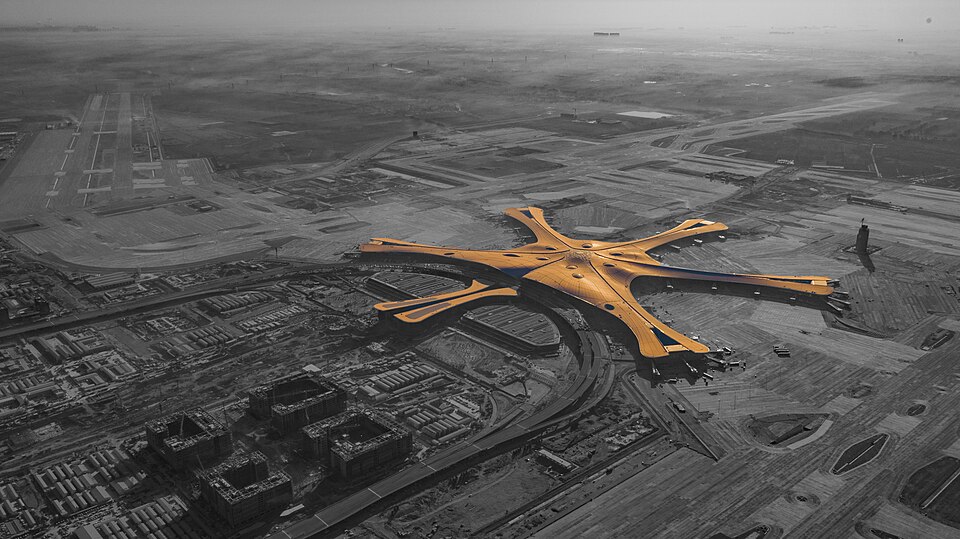
Project snapshot:
Opened in 2019, Beijing Daxing International Airport stands out among recent airport megaprojects due to its innovative design and single-building terminal scale. It combines a starfish terminal layout with four runways and a planned multi-hub operating model.
What it delivers:
- A high-capacity, ultra-efficient terminal that reduces transfer distances.
- Integrated rail and road connections into the capital region.
- Large cargo handling capacity for northern China.
Tech and design:
State-of-the-art baggage handling, integrated rail links, and passenger experience engineering in a vast single-roof terminal.
Impact so far:
Daxing Airport alleviates pressure on Beijing Capital and supports regional development corridors, serving as a focal point for air freight and long-haul connectivity.
Challenges and risks:
Balancing traffic across multiple Beijing airports and ensuring sustainable growth amid competing regional hubs.
What to watch next:
How Daxing integrates with the broader national aviation strategy and the development of new long-haul routes.
5. King Abdulaziz International Airport Expansion, Jeddah (Saudi Arabia)
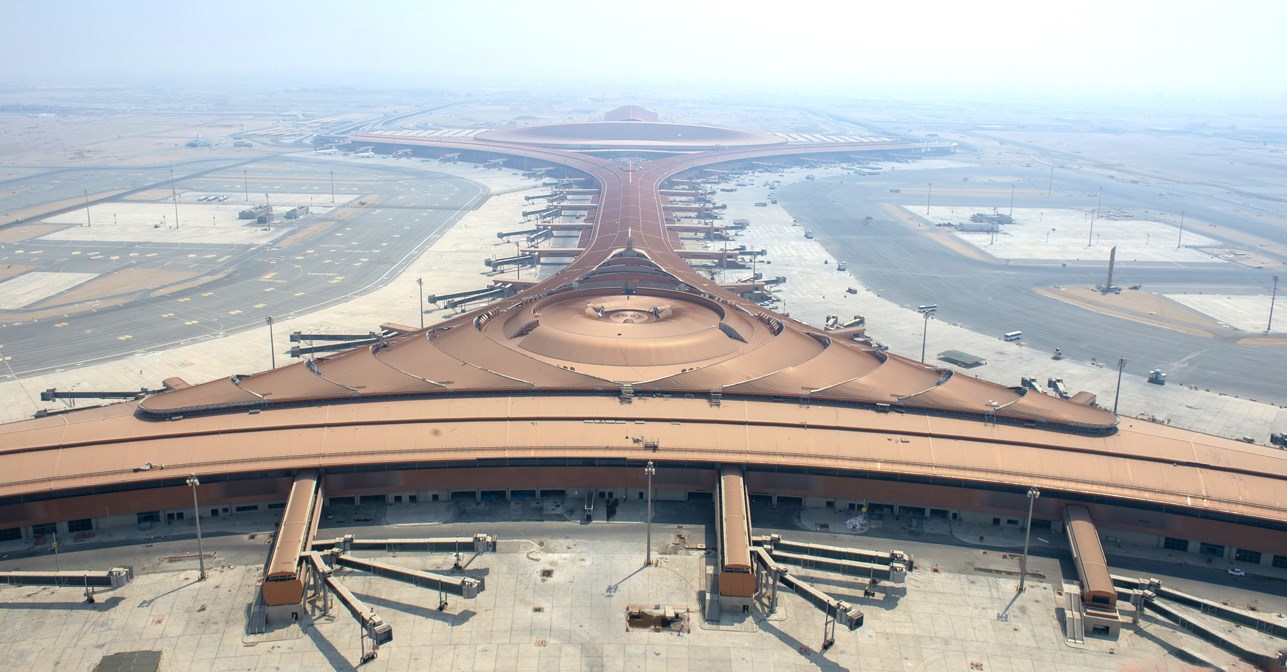
Project snapshot:
Jeddah’s King Abdulaziz International Airport redevelopment includes a new Terminal 1 and world-class people mover systems to support millions of annual pilgrims and international travellers. The program features major components in retail and hospitality.
What it delivers:
- Passenger capacity uplift and pilgrim handling efficiency for the Hajj season.
- Enhanced cargo and MRO facilities.
- Improved passenger flow for seasonal surge management.
Tech and design:
Advanced baggage automation, large retail floors, and specialised pilgrim processing areas built for high throughput.
Impact so far:
Improved international access to Jeddah and better seasonal resilience for pilgrimage travel.
Challenges and risks:
Managing peak season logistics, local environmental constraints, and integration with broader transport networks.
What to watch next:
Completion of terminal 1 and the performance of automated systems during peak pilgrim flows.
6. Navi Mumbai International Airport, India
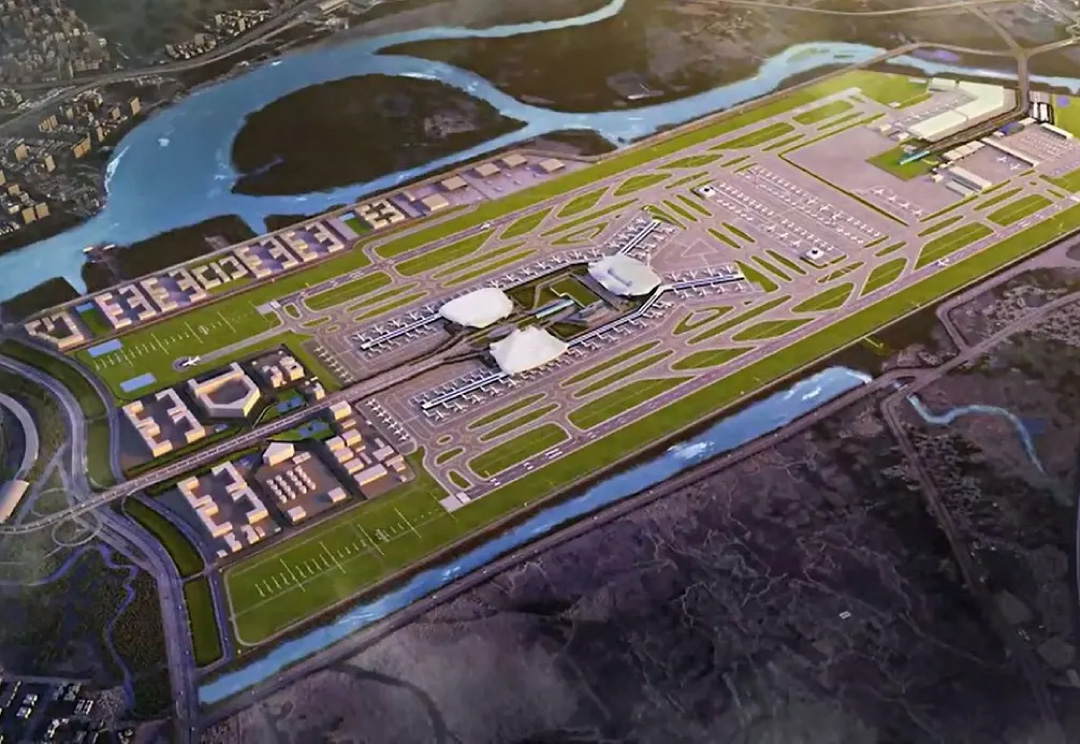
Project snapshot:
A greenfield airport developed to ease Mumbai’s congestion, Navi Mumbai International Airport is a large-scale, phased project with multi-terminal ambitions and significant cargo capacity. Early phases targeted commercial operations in 2025 and beyond.
What it delivers:
- A new gateway for India’s financial capital; rail, road, and metro integrations are central to the master plan.
- Primary cargo handling and Maintenance, Repair, and Overhaul (MRO) amenities are positioned for trade growth.
Tech and design:
Phased terminal rollouts with integrated multimodal hubs and sustainability measures such as solar and water recycling.
Impact so far:
The project has unlocked surrounding land development and logistics corridors, attracting private partners and investment.
Challenges and risks:
1160 ha land acquisition legacy issues, resettlement, and coordinating state and private stakeholders for infrastructure delivery.
What to watch next:
Opening phases and the ramping of integrated rail links and cargo terminals.
7. Noida International Airport (Jewar), India
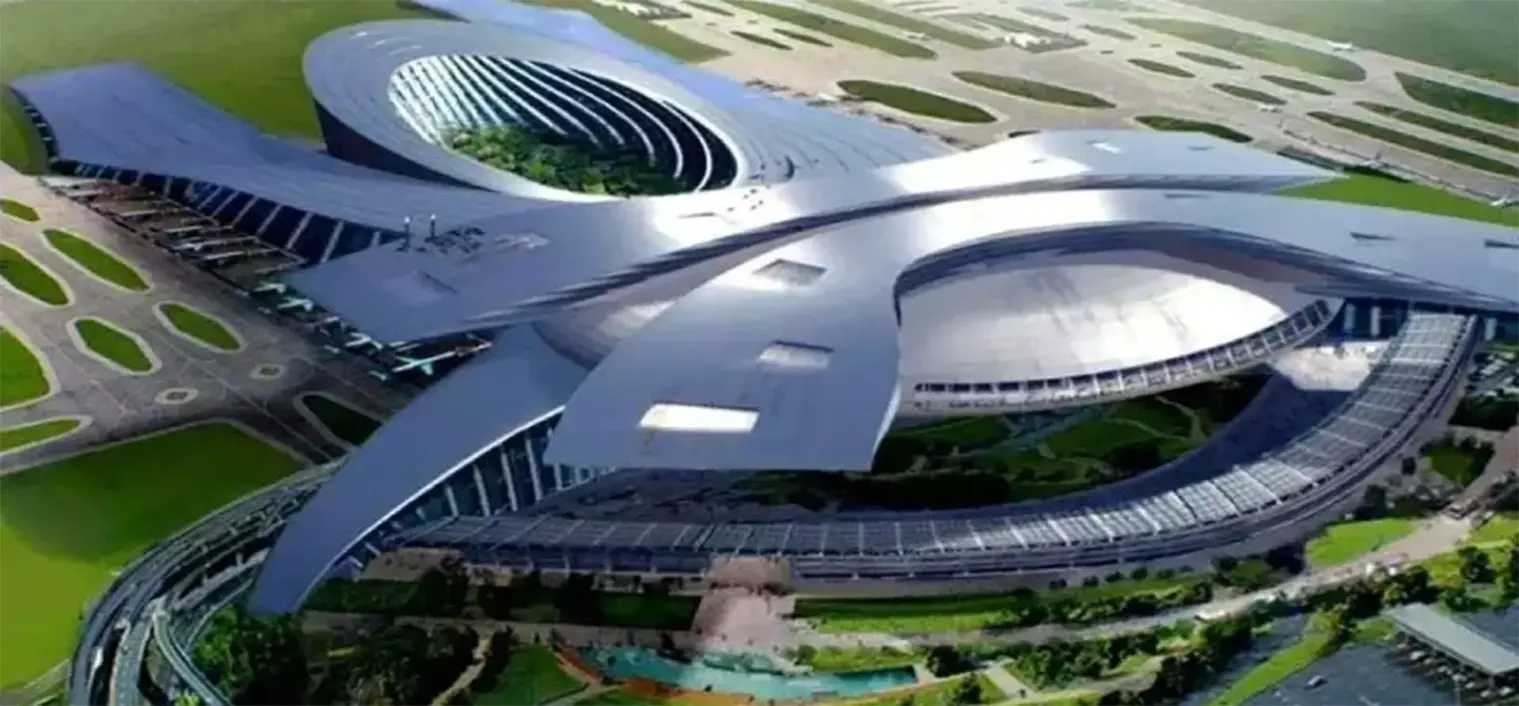
Project snapshot:
Nodia International Airport, near Jewar, Uttar Pradesh, is another ambitious Indian greenfield airport project built to serve the Delhi National Capital Region. The developer models rapid, phaseable growth from a modest opening to a multi-runway hub capable of handling tens of millions of passengers.
What it delivers:
- Decentralised capacity relieving Delhi’s existing hubs.
- A planned net-zero construction ethos and a large ground transportation centre.
Tech and design:
Presence of a modern terminal architecture, scalable runway and apron design, with an emphasis on sustainable materials and EV integration.
Impact so far:
Substantial regional infrastructure investment, such as expressway connectors (e.g., the 25 km cloverleaf EPE connector), logistics hubs, and commercial development, has followed the Jewar project.
Challenges and risks:
Timely delivery of connecting highways, metro links, and ensuring last-mile passenger access.
What to watch next:
The commissioning of commercial operations and the performance of the integrated transport hub will make it the largest airport in Asia and the fourth-largest in the world.
8. Hamad International Airport expansion, Doha (Qatar)
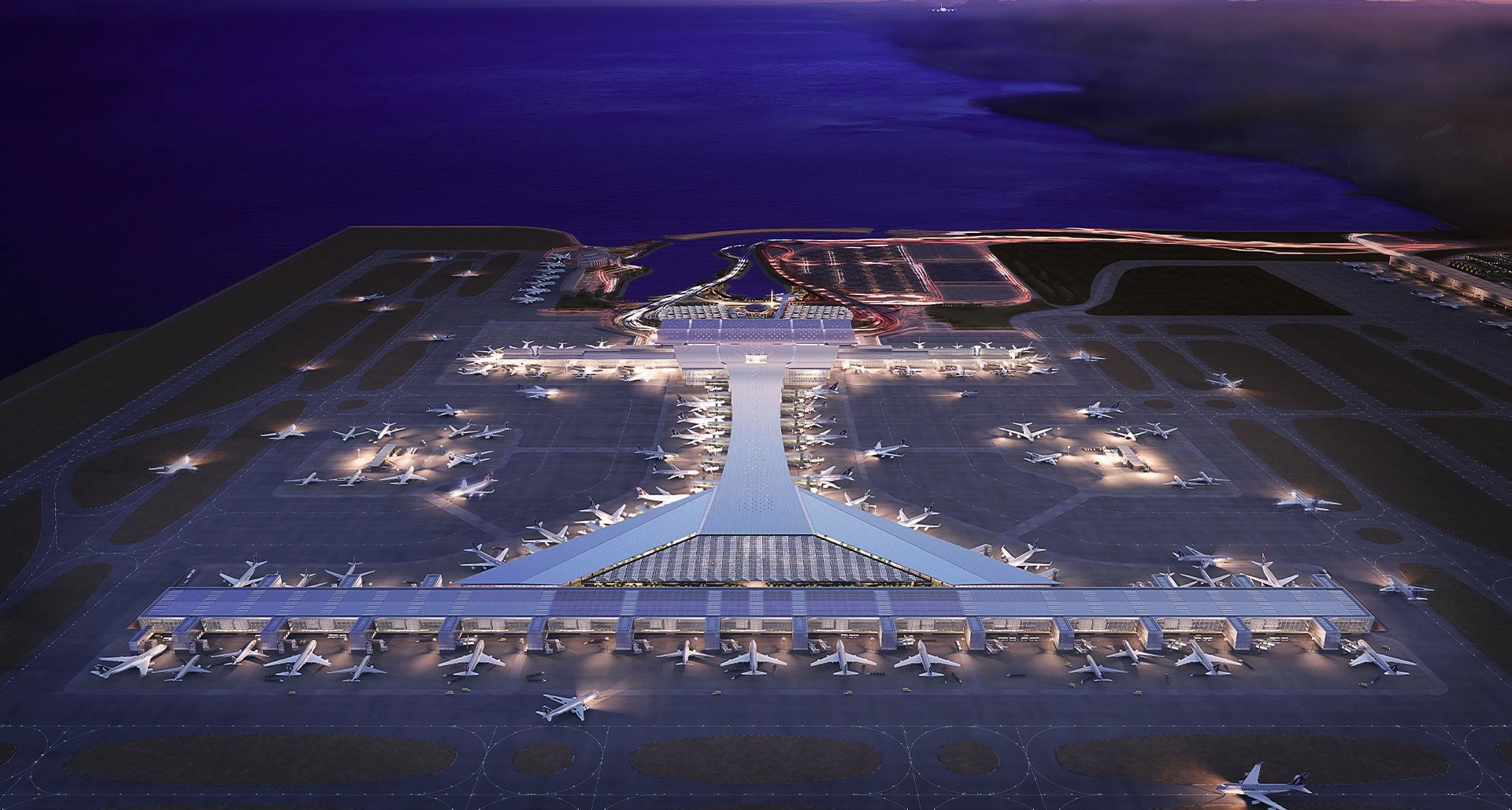
Project snapshot:
Hamad International Airport continues to grow through concourse and gate expansion programs, adding 51,000 square feet of capacity and modern passenger facilities, including eight new contact gates, to support Qatar’s aviation ambitions. Concourse E and other works have added several gates and increased annual throughput.
What it delivers:
- An additional eight contact gates and larger passenger circulation areas for smoother transfers, along with ergonomic seating arrangements.
- New retail and premium lounge capacity to support transit traffic and expand shopping and dining options.
Tech and design:
Expansion blends modular concourse additions with high automation in ground handling and passenger flows, such as advanced self-boarding technology.
Impact so far:
The airport’s incremental capacity increases maintain Doha’s position as a competitive long-haul transfer hub, supporting tourism growth with a travellers capacity of 65 million passengers per annum.
Challenges and risks:
Matching expansion tempo with airline demand and maintaining service quality as gate capacity increases.
What to watch next:
Further concourse additions and integration with Qatar’s national air route strategies.
9. Los Angeles International Airport Modernisation, USA
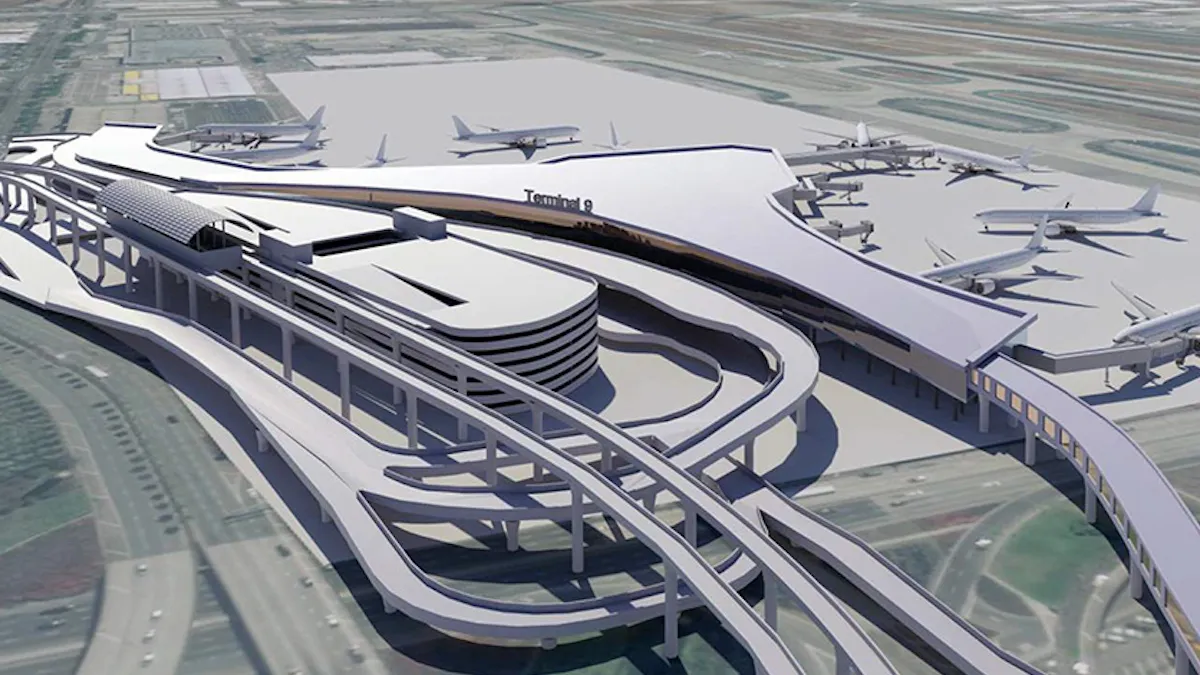
Project snapshot:
Los Angeles International Airport (LAX) is undergoing an extensive multi-billion-dollar capital improvement plan that includes the Landside Access Modernisation Program, terminal modernisation, and airfield works. The program is a notable example of how legacy hubs are being retrofitted to meet 21st-century demands.
What it delivers:
- Improved passenger access via Automated People Movers (APM) and consolidated ground transport.
- Upgrades to terminals, roadways, and utilities to support larger fleet mixes.
Tech and design:
Some of LAX’s Large-scale civil upgrades include: APM systems, a consolidated rent-a-car facility (conRAC), economy parking, and an auxiliary curb, along with modern passenger processing technologies focused on resilience and throughput gains.
Impact so far:
Early phases have improved surface access and enabled terminal refurbishments; long-term gains will reduce congestion for one of the US’s busiest gateway airports.
Challenges and risks:
Complex stakeholder coordination, high urban constraints, and maintaining operations during heavy construction.
What to watch next:
Completion of LAMP elements and measurable reductions in surface congestion and passenger journey times.
10. Frankfurt Airport Terminal 3, Germany
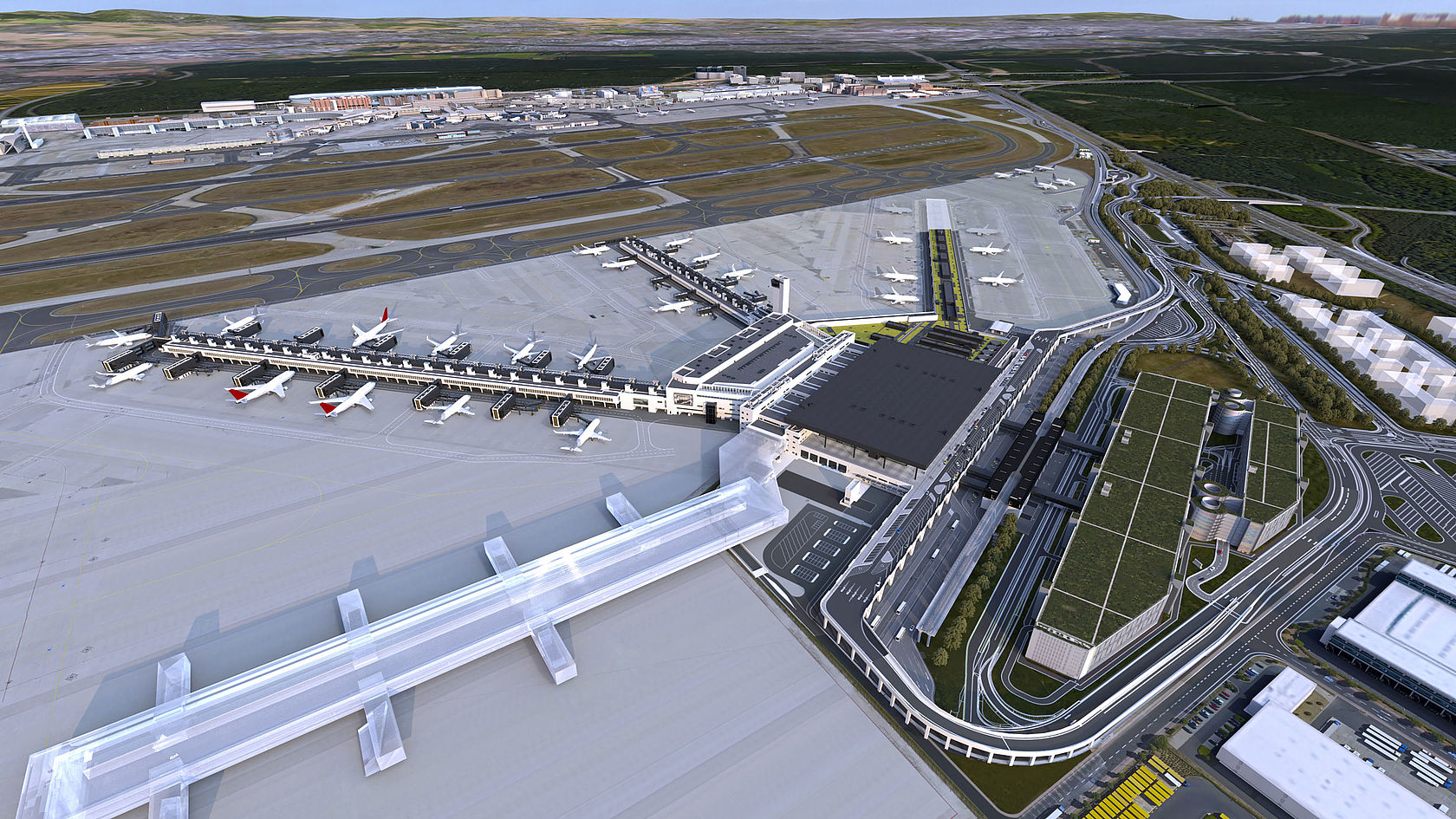
Project snapshot:
Terminal 3 at Frankfurt Airport is Europe’s biggest airport infrastructure investment in recent years and adds nearly 19 million annual passenger capacity once fully commissioned. It represents a major European public-private infrastructure undertaking.
What it delivers:
- Significant additional capacity to Europe’s busiest long-haul hub.
- Modern concourses are designed to accommodate both Schengen and non-Schengen flows, as well as efficient transfer links.
Tech and design:
Integration into the airport’s people mover, high-efficiency security and baggage systems, and scalable gate layouts. terminal3.frankfurt-airport.com
Impact so far:
The future of Terminal 3 is ambitious, whereby it will relieve pressure on older facilities and enable network resilience for Europe’s long-haul traffic patterns.
Challenges and risks:
Ensure the smooth transfer of airlines and operations into the new terminal and maintain construction timelines in a busy airport environment.
What to watch next:
Full operational ramp from 2026 and the resulting redistribution of airline slots across terminals.
Africa is also not left behind in airport infrastructure investment. Read further: Bugesera Airport: Rwanda’s $2bn Push for an Aviation Hub.
Cross-Project Themes: What These Airport Megaprojects Share
Behind each of the 10 massive airport megaprojects lies a common thread of ambition, innovation, and vision. Whether it’s Dubai’s futuristic Al Maktoum International Airport, the vast expanse of Istanbul’s air hub, or Beijing’s seamlessly connected Daxing International, these developments share more than just record-breaking budgets; they represent a redefinition of how the world moves.
Each project blends cutting-edge engineering with smart urban integration, sustainability goals, and forward-thinking design philosophies. By examining their shared DNA, let’s uncover how these massive undertakings are not only reshaping global aviation but also setting new standards for future-ready infrastructure and economic transformation.
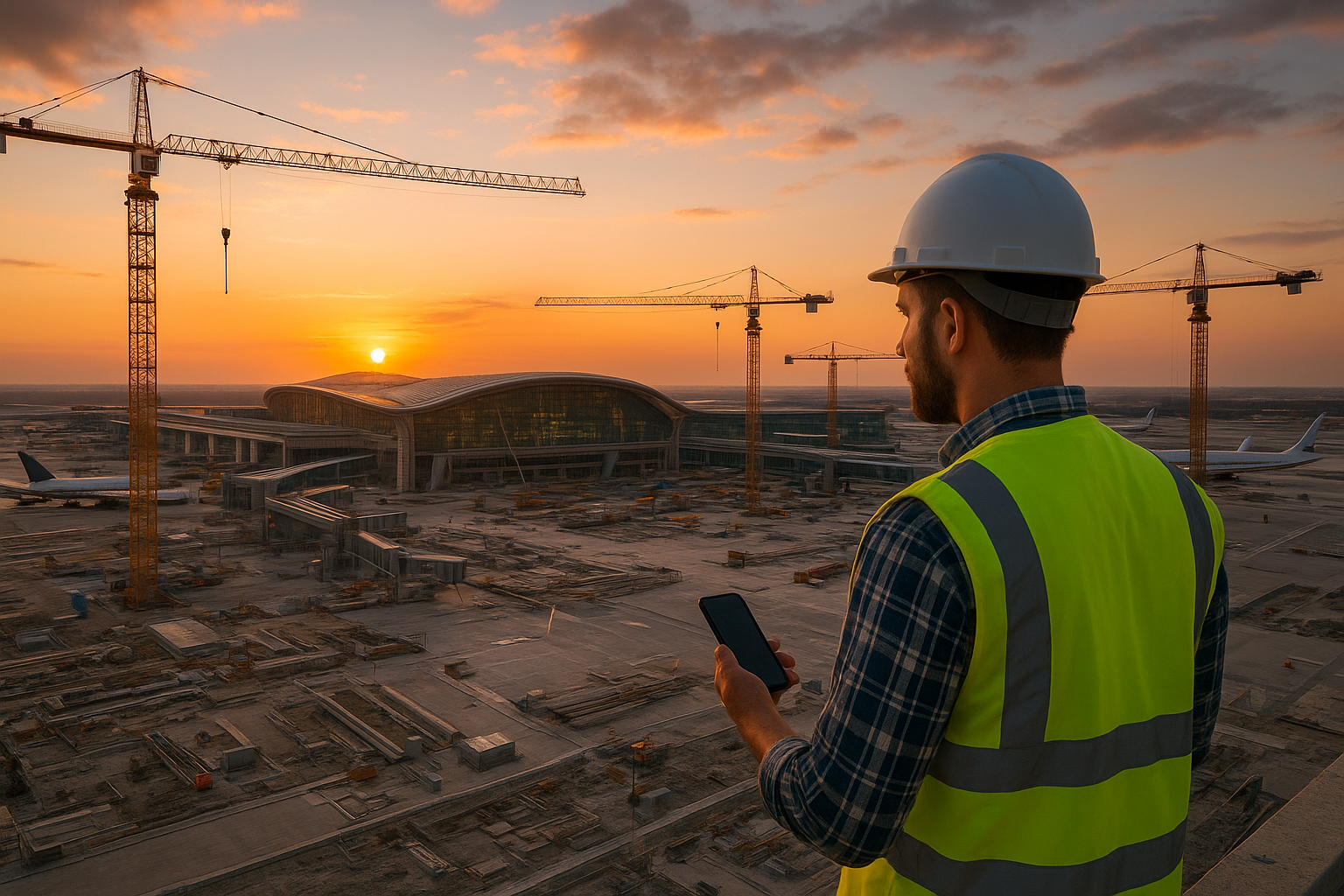
1. Capacity by Design
Every airport megaproject begins with one driving principle: anticipating tomorrow’s travel demand today. The most successful airports are not just designed for current passenger volumes but are master-planned for decades ahead.
Take Dubai’s Al Maktoum International Airport, for instance. With a projected annual capacity of 260 million passengers upon completion, its scale is anticipated to meet the Gulf’s rapid aviation growth and global transit ambitions. Similarly, India’s Noida International Airport (Jewar) and Navi Mumbai International Airport are both being developed in multiple phases to match long-term economic and population growth.
By embedding expansion into the blueprint, these airports ensure flexibility, scalability, and resilience —essential traits for infrastructure that must remain relevant in a rapidly changing world of travel.
2. Multimodal Integration
Modern airports are evolving into multimodal transportation hubs that seamlessly link air, rail, and road systems. This integration enhances accessibility, reduces congestion, and boosts economic efficiency.
For example, Istanbul Airport is connected to Turkey’s national rail and metro network, offering direct links to downtown Istanbul and future high-speed corridors. Likewise, Beijing Daxing International Airport features an advanced high-speed railway and metro integration, allowing passengers to reach central Beijing in under 20 minutes.
Such designs position airports as regional mobility anchors, not just flight terminals essential for the smooth movement of people and goods in an interconnected global economy.
3. Automation and Digital Operations
In the era of artificial intelligence and data-driven management, automation defines the future of airport operations. Advanced systems now manage everything from baggage handling to passenger screening and airfield logistics.
At Hamad International Airport, digital twin technologies model real-time passenger flows, optimising terminal layouts and reducing waiting times. Meanwhile, LAX’s Automated People Mover (APM) integrates with smart parking and check-in systems, streamlining the entire journey from curb to gate.
These innovations not only improve efficiency but also elevate the passenger experience, serving as a competitive differentiator in the post-pandemic travel landscape, where convenience and hygiene are top priorities.
4. Climate and Resilience Focus
Sustainability is no longer optional; it is a core design driver in airport infrastructure development. From energy-efficient terminal designs to advanced stormwater systems, airports are investing heavily in resilience.
King Salman International Airport in Riyadh, for example, aims to become one of the world’s largest LEED Platinum-certified airports, integrating renewable energy, green roofs, and water recycling technologies.
Similarly, Frankfurt Airport’s Terminal 3 features energy-optimised façades, advanced ventilation systems, and noise reduction strategies, striking a balance between growth and environmental responsibility. In a world of increasing climate volatility, these sustainability commitments are crucial for long-term operational stability and public approval.
5. Economic Anchors
Beyond aviation, airport megaprojects act as catalysts for regional economic ecosystems. They often spark the creation of logistics parks, free trade zones, and business districts that attract global investment.
Dubai’s Al Maktoum Airport anchors the Dubai South Aerotropolis, a 145-square-kilometre master development featuring residential, commercial, and logistics zones. Similarly, the expansion of King Abdulaziz International Airport in Jeddah has fueled growth in tourism, logistics development, and job creation across Saudi Arabia’s western region.
This strategic positioning transforms airports from mere transit points into economic multipliers, boosting GDP, trade competitiveness, and urban development far beyond their runways.
Risks, Procurement Lessons, and Financing Models
Building airport megaprojects is an extraordinary challenge in terms of engineering, logistics, and financial management. Yet the path is rarely smooth. Risk management and procurement discipline are what separate successful projects from cautionary tales.
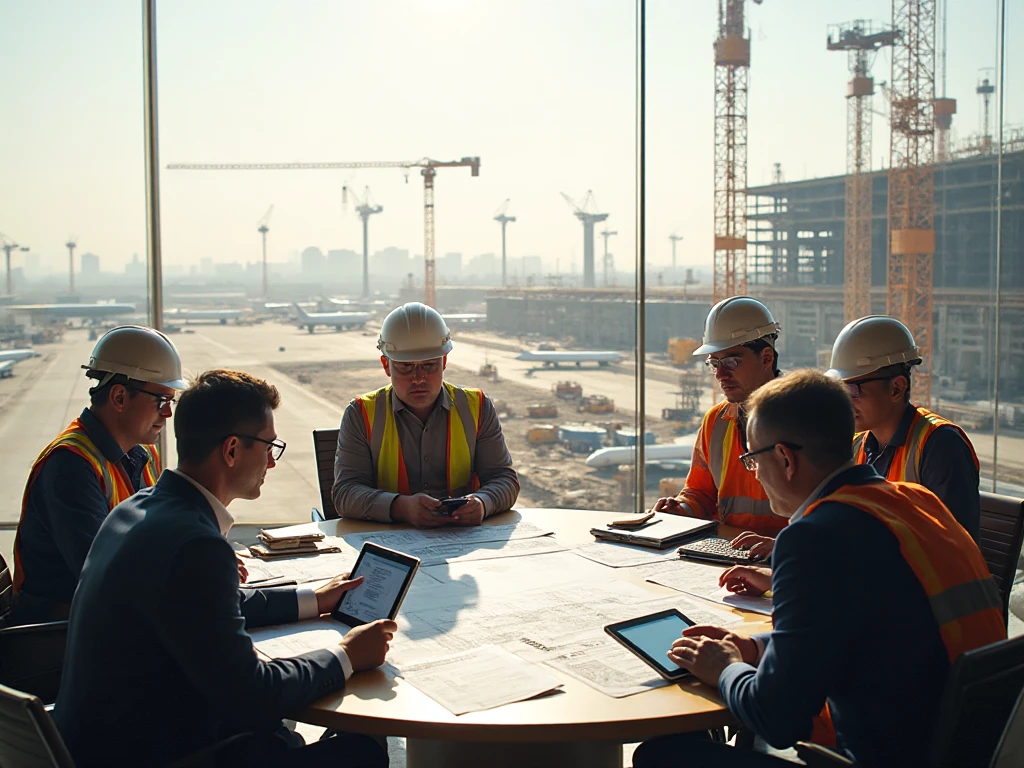
1. Phased Construction and Demand Alignment
Phasing allows airports to match expansion with demand, preventing overinvestment. Istanbul Airport’s multi-phase rollout ensured steady capacity growth while minimising idle infrastructure costs, a model now adopted by many emerging economies.
2. Public-Private Partnerships (PPPs)
Many of the most significant airport projects are financed through PPPs, combining state oversight with private capital efficiency. For instance, Navi Mumbai International Airport operates under a PPP led by the Adani Group. At the same time, LAX’s modernisation involves public funding blended with private contractor investments through design-build-finance-operate-maintain (DBFOM) frameworks.
The incorporation of such models strikes a balance between financial risk and performance accountability, enabling governments to deliver infrastructure without overburdening public budgets.
3. Procurement Standards and Transparency
Large-scale infrastructure invites large-scale risk, cost overruns, delays, or vendor lock-ins that can cripple timelines. That’s why transparent procurement and contract governance are vital. Fraport’s Terminal 3 project in Frankfurt employs open digital tendering systems and modular construction contracts to ensure clarity and accountability.
In contrast, some projects have faced challenges due to unclear scopes or shifting design standards, which have taught lessons that reinforce the importance of robust project controls and early-stage due diligence.
4. Community and Environmental Engagement
Social license to operate is now a decisive factor in project approval. From noise abatement measures in Europe to resettlement programs in India, community engagement has become a vital component in the successful operation of airports.
Projects that proactively address local concerns not only avoid costly protests and litigation but also build long-term trust between developers, governments, and citizens.
Conclusion: The Runway to Global Connectivity
Airport megaprojects are more than just infrastructure; they are symbols of national ambition and global interdependence. They embody merging engineering, architecture, finance, and policy into living monuments of connectivity. From Dubai’s futuristic Al Maktoum International Airport to India’s greenfield expansions, these projects demonstrate how nations are competing not just for passengers, but for economic influence and global presence.
Yet, the most enduring airports will not simply be the biggest. They will be the most adaptive, sustainable, and integrated with their urban ecosystems. The airports that strike a balance between digital efficiency, climate resilience, and human-centred design will define the next era of aviation.
How to Engage With the Airport Revolution
Are you part of the construction, logistics, or engineering ecosystem shaping the next generation of airports? At ConstructionFrontier.com, we provide you with exclusive insights, project breakdowns, and interviews with the teams behind the world’s most ambitious.

